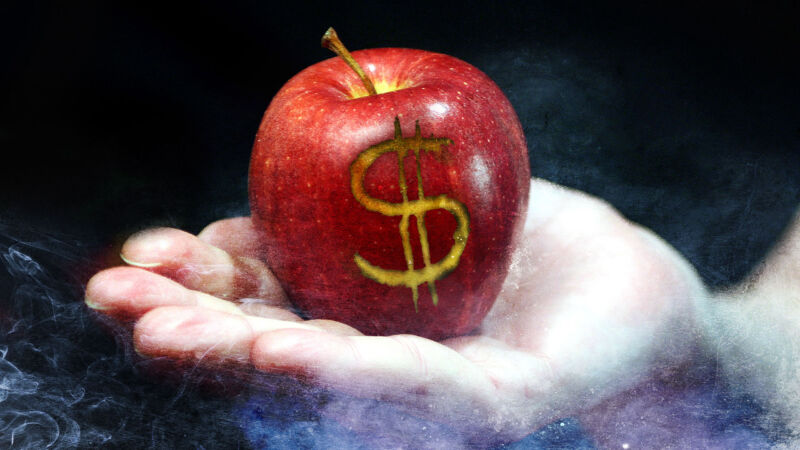Apple released iOS 16.1 and iPadOS 16.1 to the public last week, with a long list of new features, fixes, and high-priority zero-day security updates. The updates also included the latest version of SKAdNetwork, Apple's ad services framework for the App Store, and putting advertisements outside of the "Search" tab, where they had been relegated previously. Other changes included new App Store rules that give Apple a cut of NFT sales and of purchases made to boost posts within social media apps.
Whatever the intended effects of these new ad-related updates were supposed to be, indications from Apple's third-party app developers, bloggers, and users indicated the end result was a flood of irrelevant and obnoxious ads, quite often for crypto-related scams and gambling. This included quite a few instances where those ads were not just annoying but inappropriate—next to apps for kids' games or apps for gambling addiction recovery.
We contacted Apple to see whether it has anything to share about its ad rollout, and the company told us (and other outlets) that it had "paused ads related to gambling and a few other categories on App Store product pages." In the short term, the most egregious problem has been addressed, and in any case, "gambling apps advertised next to gambling addiction recovery apps" seemed like a result of unforeseen circumstances rather than something that Apple intended to happen.
But whatever the intended effect, the outcry brought to mind something I've been worried about for a while now: the rise of Apple's Services division, and why it makes me worry about where the company is headed.
Where Apple makes its money
Apple still makes the vast majority of its money from the same thing it always has: the sale of hardware. Apple has always had lesser money-making enterprises bubbling along next to its hardware business—the iTunes stores for music and video, sales for Mac OS X and pro apps like Final Cut or Logic Pro, and .Mac/MobileMe/iCloud subscriptions all brought in some money. But these were mostly side hustles or services made to create a halo effect for Apple hardware.
This is one reason why I've been a bit more comfortable inviting Apple's products into my home, compared to Google's, or Amazon's, or Facebook's Meta's, or (to a lesser extent) Microsoft's. It's about where each of those companies makes its money. If the products have no up-front cost, and most of the company's revenue is coming from ads or other kinds of targeting-derived, tracking-derived products, as the saying goes, "you are the product."
It might be pollyanna-ish of me to base purchasing decisions on this gut feeling, but as long as Apple was making most of its money from hardware sales, I could at least tell myself that the internal and external pressures on the company would incentivize a continued focus on good hardware running good software, rather than chasing click-through rates and user engagement. As Apple began to play up its focus on privacy to draw a stronger contrast between itself and Google, it seemed even more likely that Apple would resist the urge to tuck ads and pushy notifications into all of its apps.
But things have shifted, and continue to shift, on Apple's financial reports. Compare Apple's non-hardware revenue a decade ago to what it is now: in 2012, software, services, and sales of music and other media amounted to about $12 billion of the $156.5 billion Apple earned that year, or 7.7 percent. In 2022, that has climbed to $78.1 billion out of $394.3 billion, or nearly 20 percent.
This increase has been steady, and services growth has consistently outpaced the growth of Apple's hardware business for the last few years; even in 2022, a relatively slow year for Services growth, its revenue increased nearly $10 billion (14.2 percent) year over year, while all of Apple's products combined grew by $18.8 billion (6.3 percent).
Services aren't exactly eating the company's hardware business alive, but at this point it's bigger, by revenue, than the Mac and the iPad put together. And although growth has slowed somewhat through 2022, there's still likely more growth potential there than there is in hardware, since your pool of possible subscribers includes people who aren't Apple hardware owners.



3175x175(CURRENT).thumb.jpg.b05acc060982b36f5891ba728e6d953c.jpg)

Recommended Comments
There are no comments to display.
Join the conversation
You can post now and register later. If you have an account, sign in now to post with your account.
Note: Your post will require moderator approval before it will be visible.